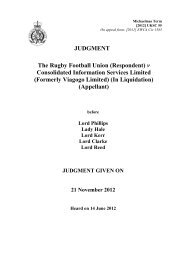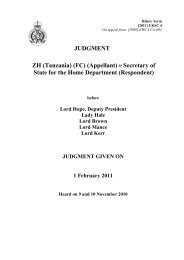Barratt Homes Limited (Respondents) v Dwr Cymru Cyfyngedig ...
Barratt Homes Limited (Respondents) v Dwr Cymru Cyfyngedig ...
Barratt Homes Limited (Respondents) v Dwr Cymru Cyfyngedig ...
You also want an ePaper? Increase the reach of your titles
YUMPU automatically turns print PDFs into web optimized ePapers that Google loves.
PRESS SUMMARY<br />
9 December 2009<br />
<strong>Barratt</strong> <strong>Homes</strong> <strong>Limited</strong> (<strong>Respondents</strong>) v <strong>Dwr</strong> <strong>Cymru</strong> <strong>Cyfyngedig</strong> (Welsh Water) (Appellant)<br />
[2009] UKSC 13<br />
On appeal from the Court of Appeal (Civil Division) [2008] EWCA 1552<br />
JUSTICES: Lord Phillips (President), Lord Saville, Lord Walker, Lady Hale and Lord Clarke<br />
BACKGROUND TO THE APPEAL<br />
The <strong>Respondents</strong>, <strong>Barratt</strong> <strong>Homes</strong> <strong>Limited</strong>, were engaged in building a substantial development of<br />
homes and a primary school in Llanfoist, near Abergavenny in Monmouthshire. They sought to<br />
exercise the right of a property owner under s 106 Water Industry Act 1991 to connect the drains to<br />
the public sewer at a point close to the development. The appellant sewerage undertakers, Welsh<br />
Water, argued that it was entitled to insist on a connection at point some 300m further downstream, as<br />
the sewer did not have the capacity to deal with the increased load until that point.<br />
Welsh Water succeeded in the High Court but the decision was reversed on appeal and <strong>Barratt</strong> <strong>Homes</strong><br />
made the connection at the place of its choice. Welsh Water pursued an appeal to the Supreme Court,<br />
seeking to establish that s 106 gave a sewerage undertaker the right to refuse to permit connection to<br />
the public sewer at an unsuitable point.<br />
JUDGMENT<br />
The Supreme Court dismissed the appeal (Lady Hale dissenting). The judgment of the<br />
majority was given by Lord Phillips.<br />
REASONS FOR THE JUDGMENT<br />
The exercise of the right of a property owner to discharge into a public sewer pursuant to s 106<br />
Water Industry Act 1991 (‘the 1991 Act’) was an absolute right which could not be prevented<br />
on the ground that the additional discharge would create a nuisance. That was for the<br />
sewerage undertaker to deal with [paras 23-26]. The right to object to the ‘mode of<br />
construction’ in s 106(4) did not extend to the point of connection [para 32]. It was<br />
significant that in nearly a century and a half since the first enactment conferring this right was<br />
passed, this was the first dispute between an owner and sewerage undertaker as to the point of<br />
connection to a public sewer to have reached the courts [para 38].<br />
The real problem behind the dispute in this case lay in the requirement to give only 21 days’<br />
notice to a sewerage undertaker before exercising the absolute right in s 106. This was<br />
manifestly unsatisfactory in relation to a development which in this case would add 25% or<br />
more to the load on the public sewer [para 41]. The only way to achieve a deferral of the<br />
The Supreme Court of the United Kingdom<br />
Parliament Square London SW1P 3BD T: 020 7960 1886/1887 F: 020 7960 1901 www.supremecourt.gov.uk
ight was through the planning process, in which both the sewerage undertaker and OFWAT<br />
should be consulted. More thought might need to be given to the interaction of planning and<br />
water regulation systems under modern law to ensure that the different interests were<br />
adequately protected [paras 57-58].<br />
The 21 day limit for refusing applications to connect to the public sewer in s 106(4) was<br />
mandatory, in view of the fact that it was a criminal offence to connect a drain after such<br />
notice had been given [para 62].<br />
Lady Hale would have allowed the appeal on the construction of s 106(4). The legislative<br />
history led her to conclude that Parliament had not intended to cut down the scope of the local<br />
authority’s power to control the place and manner of connection in the Public Health Act 1936<br />
(the predecessor to the 1991 Act), while leaving the position in Scotland unchanged [para 73].<br />
The words ‘mode of construction or condition’ in s 106(4) should be interpreted as including<br />
the place of connection to the public sewer [para 79].<br />
NOTE<br />
This summary is provided to assist in understanding the Court’s decision. It does not form<br />
part of the reasons for the decision. The full judgment of the Court is the only authoritative<br />
document. Judgments are public documents and are available at:<br />
www.supremecourt.gov.uk/decided-cases/index.html<br />
The Supreme Court of the United Kingdom<br />
Parliament Square London SW1P 3BD T: 020 7960 1886/1887 F: 020 7960 1901 www.supremecourt.gov.uk



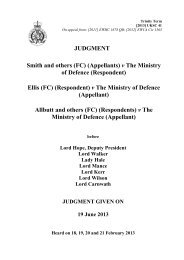
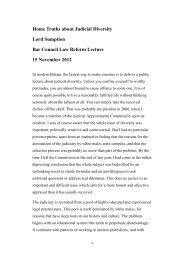



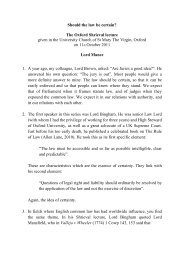

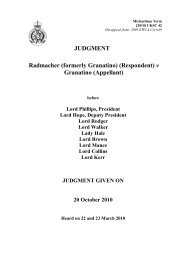
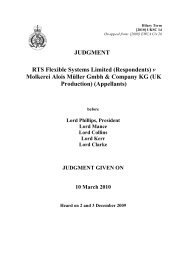

![[2009] UKSC 10 - The Supreme Court](https://img.yumpu.com/8582038/1/184x260/2009-uksc-10-the-supreme-court.jpg?quality=85)
